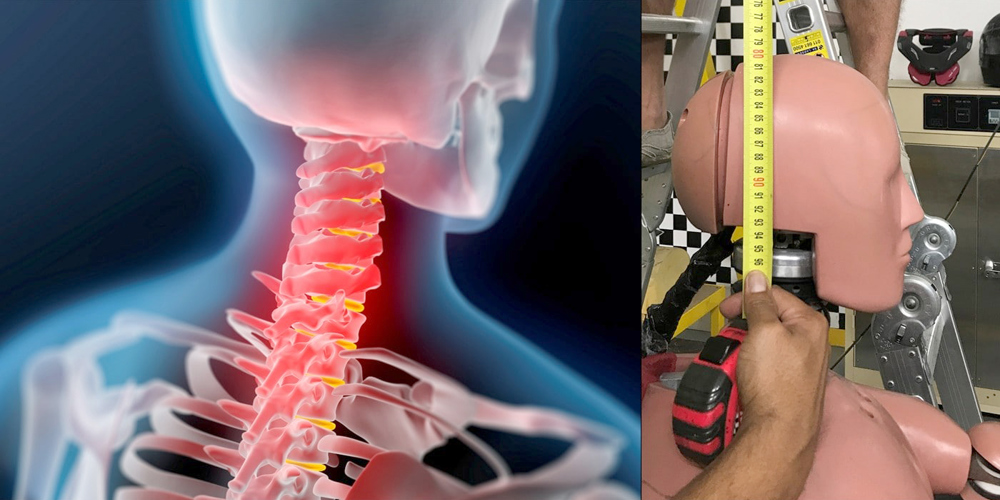A young male was involved in a late-night physical altercation outside a filling station rendering him paraplegic. The gentleman was reportedly assaulted by another male after a disagreement, whereby he was allegedly lifted and “spear tackled” into the side of a parked vehicle, striking the top of his head (vertex). He momentarily lost consciousness but remembered waking up having no feeling in his legs and being unable to move. The gentleman who allegedly assaulted him claims to have acted out of self-defense and that he merely pivoted and pushed him away after an attempted attack, after which the plaintiff stumbled and fell backwards striking the car with the back of his head (occipital area).
Attorneys representing the plaintiff reached out to one of our bio-mechanical experts to determine the most likely scenario resulting in the plaintiff’s injuries, i.e., impact on the vertex of the head as opposed to impact on the occipital area of the head.
Our Approach
Post-incident medical records indicated a compression flexion Grade 5 (CF Grade V) fracture of C7. A literature review revealed that these injuries are typically classified with compression as the primary loading modality with secondary flexion due to instability of the affected segment. These injuries are associated with high impact energy transfer and rapid onset of peak axial compressive loading to the affected cervical segment (typically within 15-20 msec), resulting in vertebral burst-type fracture with possible retropulsion of bone fragments into the spinal canal.
Next, tests utilizing an instrumented Hybrid III ATD (crash test dummy) were conducted to establish comparative lower neck (C7/T1) compressive loads associated with impacts directed to the vertex as opposed to the occipital area of the head. Vertex tests were conducted utilizing an equal to body mass impact pendulum striking the top of the head, whilst occipital tests were conducted with the ATD swinging into a flat impact anvil. This resulted in the head impact energy for both test scenarios mimicking the energy imparted when falling over backwards from standing.
Finally, a geometric analysis of the incident site was conducted to determine whether (1) there was enough space for the defendant to push plaintiff in order to stumble, trip and then fall backwards onto the car, hitting the back of his head, (2) there was enough space for the defendant to lift the plaintiff and spear tackle him into the side of the car.
Test results revealed an inverse relationship between the compressive loads and bending moments experienced by the neck during vertex impacts and occipital area impacts under the same impact energy. This aligned well with published data, explaining the expected injury outcomes for changing impact eccentricity, with vertex impact more often associated with burst type fractures due to high compressive loading, and impacts to the back of the head associated with non-related posterior ligamentous injury due to high bending moments.
Vertex impact tests resulted in peak axial loads surpassing the allowable neck injury threshold within 10-15 msec after impact. This agreed well with classification and descriptors for CF type injuries resulting from near vertex impacts. Occipital impact tests resulted in low axial loads with slow onset of peak loading, as well as higher bending moments, more closely related to Distraction Flexion (DF) injuries such as ligamentous strains. Plotting the peak compressive loads for the two test conditions on an injury risk curve indicating the probability for serious lower cervical spine injury, clearly showed that a vertex impact was more likely to have caused the CF injuries sustained by plaintiff (see figure below).
Furthermore, a geometric analysis of the incident site showed that there was likely not enough space for the defendant to have pushed the plaintiff from where he was standing to where the plaintiff hit the car. According to testimony by the defendant, the plaintiff was pushed, stumbled, and then fell over backwards. This description would have the plaintiff hit the car somewhere on his lower or mid back rather than the back of his head.
Services Utilized
Expertise Utilized
The Outcome
A young male was involved in a late-night physical altercation outside a filling station rendering him paraplegic. ESi performed biomechanical tests using an instrumented crash dummy and analyzed medical records. The results of this analysis were presented as expert testimony during trial. A favorable verdict for the plaintiff was returned

